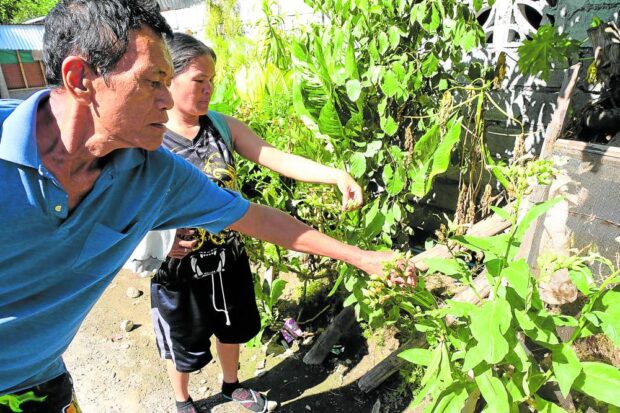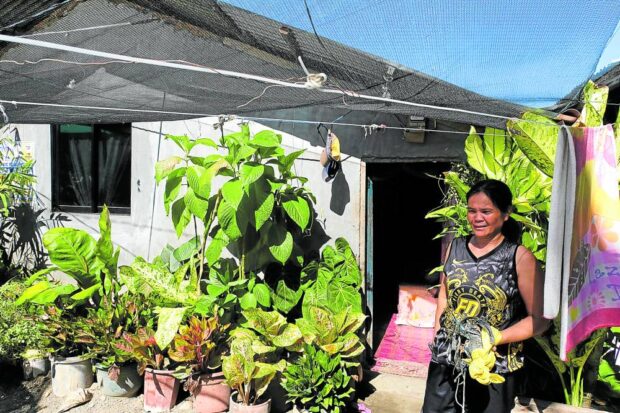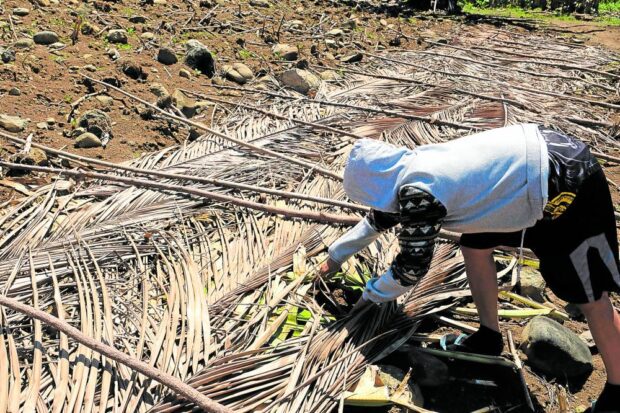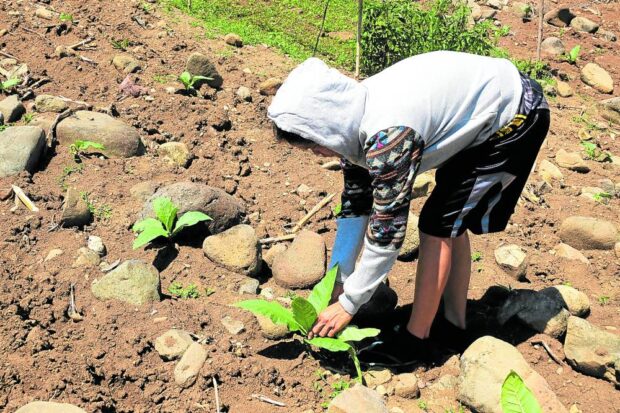Tobacco farming changes lives in coastal Sarangani
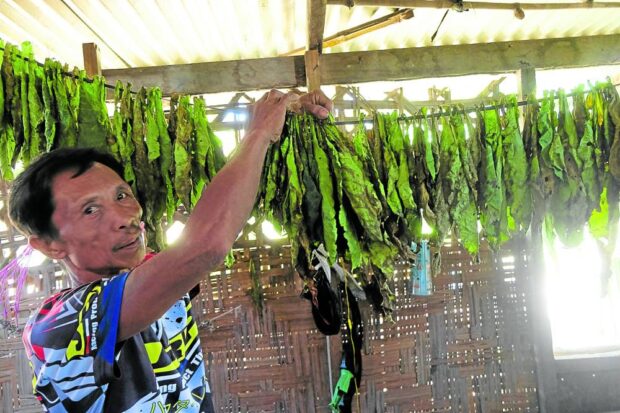
SOURCE OF LIVELIHOOD | Buenaventura Pales (above) arranges tobacco leaves undergoing the natural curing process in a farming community in Alabel, Sarangani. (Inset) Agapito Layan Sr. and Jacquilyn Cobol-Layan take out the seeds of tobacco for propagation. (Below) Jacquilyn says their family’s house was built over time from her tobacco farming income. (Photo by BONG SARMIENTO / Inquirer Mindanao)
ALABEL, Sarangani, Philippines — For the past four decades, tobacco, unknown to many, has been cultivated in this coastal town, helping dozens of families to survive and lead better lives.
One of them is the family of Jacquilyn Cobol-Layan who, from a simple “bahay kubo” (thatched hut), now lives in a modest concrete house, built in the course of 10 years.
She and her partner, Arnel Layan, in fact, belong to the second generation of tobacco planters in this town, the seat of the Sarangani provincial government.
Tobacco farming in Alabel originated from Negros Oriental, after several farmers from the Visayan province came to this part of the south four decades ago, apparently lured by the promise of Mindanao’s agricultural riches.
Until now, the crop continues to thrive and benefits dozens of families in Barangay Spring, about 10 minutes away from the población (town center) by motorcycle, the main mode of transportation in this first-class locality with a population of at least 88,000.
“If not for tobacco farming, we would not be able to live in a concrete house. We built this slowly over the years. After we harvest tobacco, we would buy some construction materials for our dream house,” Jacquilyn told the Inquirer in Binisaya.
Almost every day for six months a year in the last nine years, Jacquilyn would accompany Arnel to the farm to take care of their tobacco plants.
Jacquilyn has four children from a previous relationship and they are with their father. Arnel also has two children from a previous relationship and are now living with them. Jacquilyn and Arnel have no children of their own.
All their respective children are enrolled in Grades 6 to 11. “Tobacco farming helped us send them all to school,” Jacquilyn said, adding that she regularly sends allowance to her children from their farming income.
Better than corn
Tobacco is meticulous to cultivate and requires “daily attention,” Jacquilyn stressed, noting, “Halos di na gani mi kasimba (We can barely attend church services).”
It was Arnel who first learned tobacco cultivation from his father, Agapito Layan Sr., who taught the farming techniques to his children.
Of the seven Layan siblings, six pursued the planting of tobacco that takes six months to harvest, and at least 18 days for curing before these are sent off to the market.
“The income from tobacco farming is way better than corn farming. I raised my family mostly from tobacco farming,” said Agapito, smoking paper-wrapped tobacco grown in his half hectare farm.
On a good harvest, Agapito said he could earn P150,000 from tobacco which, according to him, is three times the net income from corn.
For the “first-class” or those in the upper part of the tobacco plant, a bunch of 100 leaves is bought by their buyer at P600.
Agapito plants tobacco once a year and after harvest, would either plant corn or vegetables to complete the annual farming cycle.
Corn, which can be harvested after four months, is capital intensive in terms of the inputs, the reason why Agapito stuck to tobacco farming for almost 40 years.
Tobacco can be ratooned but the yield becomes less compared to planting new seedlings, he said.
Although tobacco farming did not make them rich, Agapito, with the help of wife Antonia, stressed that it allowed them to sustain the basic needs of the family and paved the way for their seven children, now all having their own families, to study until high school.
Agapito and Antonia, who are in their 60s, both smoke tobacco produced from their farm, and do not buy cigarettes sold in the neighborhood stores. They claimed the tobacco they smoke “does not have a negative effect on their health unlike the cigarettes that undergo the manufacturing process.”
Demand
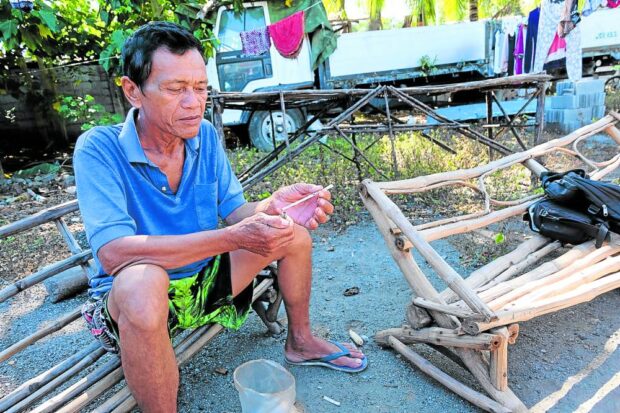
SOURCE OF LIVELIHOOD | Buenaventura Pales (above) arranges tobacco leaves undergoing the natural curing process in a farming community in Alabel, Sarangani. (Inset) Agapito Layan Sr. and Jacquilyn Cobol-Layan take out the seeds of tobacco for propagation. (Below) Jacquilyn says their family’s house was built over time from her tobacco farming income. (Photo by BONG SARMIENTO / Inquirer Mindanao)
In a briefer, the National Tobacco Administration (NTA) said that while tobacco “is pinpointed as cancer-causing, it is considered by many as a panacea for many ailments. It may yet be the plant of manifold use as research continues to discover industrial and pharmaceutical products from the leaves as well as from its byproducts.”
The Philippines approved Republic Act No. 9211, or the Tobacco Regulation Act of 2003 to regulate the use, sale and advertisement of tobacco products.
The law does not ban the cultivation of tobacco, which is widely grown in the Luzon provinces of Ilocos Sur, Ilocos Norte, Abra, La Union, Pangasinan, Isabela, Cagayan, Nueva Vizcaya, Quirino, Tarlac and Occidental Mindoro, NTA data showed.
In Mindanao, aside from Sarangani, tobacco is grown in Bukidnon, Maguindanao, Misamis Oriental, Cotabato and Zamboanga del Sur, it added.
In 2021, the value of tobacco produced in the Philippines amounted to around P5.71 billion, market and consumer data provider Statista (statista.com) said in a report published in September 2022.
According to Agapito, they continue to plant tobacco since there is a demand in General Santos City and in Sarangani province, as accompaniment for betel nut or “mama” chewing, aside from the unprocessed tobacco popular in remote villages or in the mountains.
According to him, the only chemical they apply to propagate tobacco is pesticides to kill worms. The weeds are being pulled out manually as spraying them with herbicides will kill the tobacco plants, Jacquilyn said while touring the Inquirer at her farm, which is just near Agapito’s.
The Layans who are into tobacco growing—seven in all—each maintain a farm ranging from a fourth to half hectare.
A few blocks away from the Layan compound, another veteran tobacco farmer, Buenaventura Pales, 66, shared how the crop helped him and his wife raise their four children, who all finished high school.
“I am a son of a tobacco farmer. My father used to work in a large tobacco plantation in Negros Oriental until he brought us here in the 1970s,” Pales narrated.
The fifth of eight siblings, Pales said their parents also brought them up from the hardship of tobacco farming.
“It is not easy to grow tobacco, it is labor-intensive, but I’m proud that we managed to make it sustainable until now,” said Pales, whose two children had followed in his footsteps as a tobacco farmer.
Ever since locals cultivated tobacco, they don’t have a problem with planting materials since the existing plants bear seeds they can propagate.
The seeds are sowed in a bed of soil and fully covered from the sun by available farm materials such as coconut fronds or banana leaves. If there’s no rain, they are watered daily until the sprouts come out and replanted manually in the field after about one-and-a-half month.
Pales said he would not stop planting tobacco while he has the strength to do farm work. “My father stopped planting tobacco when he was 80 years old,” he said.
Gov’t help needed
But local tobacco farmers here are apparently out of the radar of the Department of Agriculture’s (DA) programs.
“We hope the concerned government agency will extend assistance to our tobacco venture,” Pales appealed, the same plea that Jacquilyn aired.
“There’s no government help extended to our tobacco production in the village,” Jacquilyn said.
Shiery Chris Zulueta, agriculture officer at the Alabel municipal agriculture office, admitted that the tobacco farmers had not received assistance since the DA’s thrust, as well as that of the local government, was focused more on boosting food production.
“Unfortunately, tobacco farmers here are not the priority. The priority is the food farmers,” she said.
Local tobacco farmers need easy access to long-term financing, the provision of farm inputs to boost their production and marketing assistance, Jacquilyn said.
“We can afford to pay the loan from the proceeds of our tobacco harvest,” she said.
